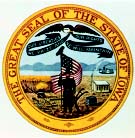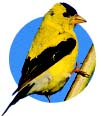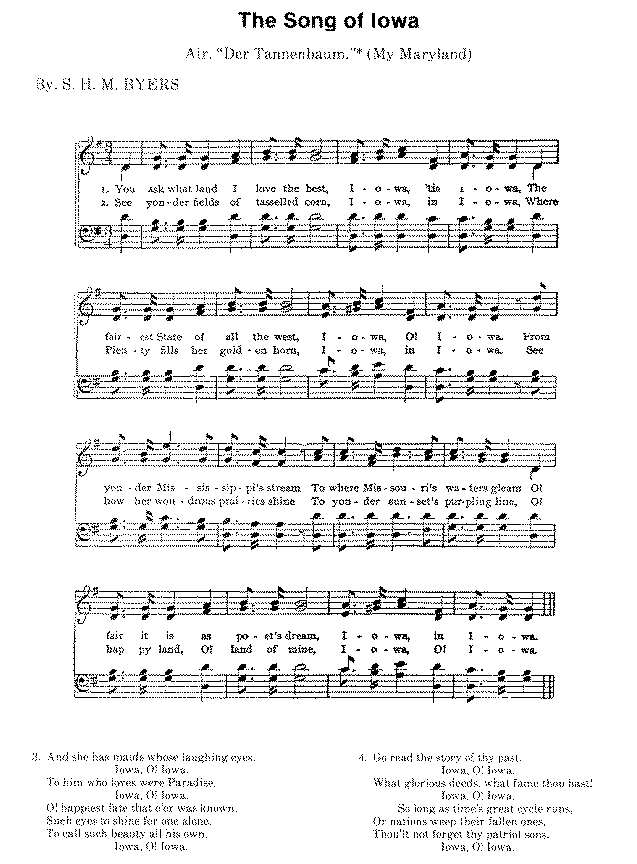|
| |||||||||||
|
IOWA OFFICIAL REGISTER | |||||||||||
|
STATE SYMBOLS OF IOWA | |||||||||||

| |||||||||||
STATE BANNER | |||||||||||
|
Iowa was almost 75 years old before the state banner was adopted by the General Assembly. Creation of a state banner had been suggested for years by patriotic organizations, but no action was taken until World War I, when Iowa National Guardsmen stationed along the Mexican border suggested a state banner was needed. The guardsmen said regiments from other states had banners and they felt one was needed to designate their unit. This prompted the state's Daughter's of the American Revolution (DAR) to design a banner in 1917. The General Assembly officially adopted the design in 1921. With the memory of the Civil War still fresh in their minds, Iowans had not adopted a state banner because they felt a national banner was the only one needed. Approval of the banner was aided by patriotic organizations that launched a campaign to explain that a state banner was not meant to take the place of the national emblem. The banner, designed by Mrs. Dixie Cornell Gebhardt of Knoxville and a member of the DAR, consists of three vertical stripes of blue, white and red. Gebhardt explained that the blue stands for loyalty, justice and truth; the white for purity; and the red for courage. On the white center stripe is an eagle carrying in its beak blue streamers inscribed with the state motto: "Our liberties we prize, and our rights we will maintain." The word Iowa is in red below the streamers. All schools must fly the state banner on school days. The banner may be flown on the sites of public buildings. When displayed with the United States flag, the state banner must be flown below the national emblem. | |||||||||||

| |||||||||||
THE GREAT SEAL OF THE STATE OF IOWA | |||||||||||
|
One of the initial acts of the first General Assembly in 1847 was to create the Great Seal of Iowa. The two-inch diameter seal pictures a citizen soldier standing in a wheat field, surrounded by farming and industrial tools, with the Mississippi River in the background. An eagle is overhead holding in its beak a scroll bearing the state motto: "Our liberties we prize, and our rights we will maintain." The motto was the work of a three-member Senate committee and was incorporated into the design of the seal at their suggestion. The Great Seal cannot be used without the permission of the governor. The state seal is retained in the custody of and under the control of the governor, who uses the seal for official documents and functions. | |||||||||||
|
Graphics of the state symbols were provided by the Dept. of Economic Development, Division of Tourism. | |||||||||||

| ||||||||||
STATE FLOWER
| ||||||||||
|
The 26th General Assembly designated the wild rose as the official state flower in 1897. It was chosen for the honor because it was one of the decorations used on the silver service which the state presented to the battleship USS Iowa that same year. Although no particular species of the flower was designated by the General Assembly, the wild prairie rose (rosa pratincola) is most often cited as the official flower. Wild roses are found throughout the state and bloom from June through late summer. The flower, in varying shades of pink, is set off by many yellow stamens in the center. | ||||||||||

| ||||||||||
|
STATE BIRD
| ||||||||||
|
The General Assembly designated the eastern goldfinch, also known as the American goldfinch and the wild canary, as the official state bird in 1933. It was chosen as the state bird because it is commonly found in Iowa and often stays through the winter. Seeds from dandelions, sunflowers, ragweed, and evening primrose are the main source of food for the eastern goldfinch (carduelis tristis). In late July or early August they build their nests from plant materials and line them with thistledown. The pale blue-white eggs of the eastern goldfinch incubate for two weeks and the young birds leave the nest when they are two or three weeks old. The top of the male's head is topped with black. The bright yellow body has black wings and tail. The female has a dull olive-yellow body with a brown tail and wings. The male goldfinch acquires the same dull plumage in the winter months. | ||||||||||
|
| ||||||||||

| ||||||||||
|
STATE ROCK
| ||||||||||
|
The Iowa General Assembly designated the geode as the official state rock in 1967. Because Iowa is well known for the presence of the geode, it was chosen as the official rock in an effort to promote tourism in the state. Legislators who favored making the geode the state rock pointed out that it is among the rarest and most beautiful rocks and that Iowa is known worldwide because of the large number found in the state. Other rocks considered for official status were limestone and fossil coral. In Latin, the word geode means earthlike. Geodes are shaped like the earth and average about four inches in diameter. Geodes are found in limestone formations and have a hard outer shell. When carefully broken open, a sparkling lining of mineral crystals, most often quartz and calcite, is revealed. Geologists attribute the crystal growth to the percolation of groundwater in the geologic past. Southeastern Iowa is one of the state's best Geode collecting areas. Geode State Park in Henry County is named for the occurrence of the geode. | ||||||||||

| ||||||||||
|
STATE TREE
| ||||||||||
|
The oak was designated as the official state tree in 1961. The General Assembly chose the oak because it is abundant in the state and serves as shelter, food and nesting cover for many animals and birds. It is difficult to find a tract of natural woodland in Iowa that does not harbor at least one species of oak. No other group of trees is more important to people and wildlife. Acorns, the nuts of oak trees, are a dietary staple of many animals and birds. Wild turkeys, pheasants, quail, wood ducks, raccoons, squirrels, chipmunks, bluejays, nuthatches, grackles, and several kinds of woodpeckers are a few of the species that depend on acorns for a significant portion of their diet. | ||||||||||
|
| ||||
|
| ||||||
|
There is frequently much confusion as to the status of the so-called state songs, due largely to the fact that they may be chosen by official action, by popular approval, or by a combination of the two methods. In the Middle West particularly, where state boundaries are artificial and the population has constantly shifted, it is not surprising that there should be much uncertainty. There have been many aspirants to the honor of writing the state song for Iowa, but only three or four of these songs have received noteworthy official or popular recognition. First in point of time and official recognition is The Song of Iowa, the words of which were written by S.H.M. Byers, who give the following account of the inspiration of the song:
| ||||||
|
Many years later, in 1897, Mr. Byers carried out his wish and wrote a song to the music of Tannenbaum, the old German folk-song which the Confederates had used for My Maryland. The next night a French concert singer at the Foster Opera House in Des Moines sang the new song upon the request of Mr. Byers. The number was a great success and was encored again and again. While Major Byers thus had the honor of writing Iowa's official song, the best known and most popular song of the state is the famous "Iowa Corn Song," which every loyal son and daughter of the Hawkeye State sings lustily on any and all occasions, reaching their hands as high toward Heaven as they possibly can when the words roar forth "That's where the tall corn grows." This famous song was written by George Hamilton, secretary of the Des Moines Chamber of Commerce and a big man in the Masonic Lodge, particularly among Shriners, with later help from Prof. John T. Beeston, the well known band leader; sung to the tune of "Traveling." George Hamilton started the song back in 1912 when a delegation of Za-Ga-Zig Shriners had gone to Los Angeles, California, to participate in the huge Shrine convention, and it was realized that what Iowa needed was a rousing marching song, which should advertise the chief product of the state: Corn. So Hamilton wrote the original stanza, dealing mainly with the glories of the Shrine, and tacked on the original and still-intact chorus, which is far the best known and most rousing part of the song. Hundreds of later verses have been added by Hamilton himself, Professor Beeston and others, but as it is published and usually sung, the song goes in this manner:
Let's sing of grand old I O W A Y,
* "Der Tannenbaum," the old air to which this song is sung, was a popular German students' song as early as 1849. It had been a Volks song long before that. During our Civil War, the Southerners adapted it to the song, "My Maryland." | ||||||
